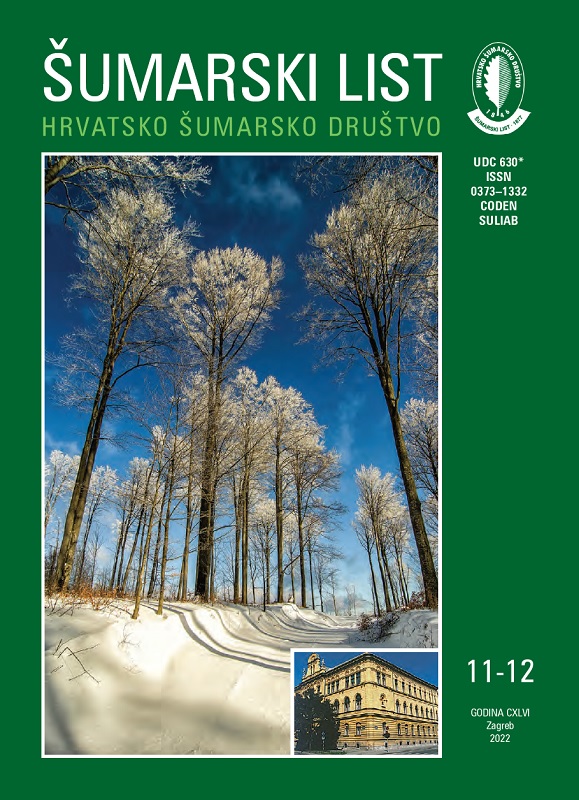
broj: 11-12/2022
pdf (8,7 MB) |
|
||||||||||||||
| RIJEČ UREDNIŠTVA | ||
| Uredništvo | ||
| At the end of 2022 pdf HR EN | 473 | |
| Editorial As in all the years preceding this one, we have tried to be up-to-date and express our thoughts not only on Croatian forestry but also on European and world forestry. The dynamics of various changes that are taking place on Planet Earth is increasingly affecting Croatian forests and forestry. This topic was discussed in several of our editorials. Thus, the same topic of energy appeared in the editorials of issue 3-4/2022 under the title “Do we use biomass as an energy source? If so, how do we use it?” and of issue 7-8/2022 entitled “Why do we lag behind in the green transition and energy independence?” Both headlines ended with a question mark, but the questions raised in the texts are still without answers. That this topic has been relevant for a long time can be deduced from the fact that it was already relevant in 2010. After all, the Croatian Forestry Association founded its section in 2005 under the name of Croatian Biomass Association as early as 2005. Through its activity of 17 years, the section has played a pioneering role in clarifying the importance of and educating about the use of the resources from our forests. The intention was to direct the Republic of Croatia towards reducing the use of fossil fuels and greenhouse gas emissions and increasing energy independence and climate neutrality. The editorial in issue 5-6/2022 referred to the 15th World Forestry Congress held at the beginning of May in South Korea. The congress was held under the motto “Building a Green, Healthy and Resilient Future with Forests”. One of the conclusions read as follows: “Forests transcend political, social and environmental boundaries and are vital for biodiversity and the carbon, water and energy cycles at a planetary scale.” Prompted by past bad experience in the application of various declarations at the global level, we can only hope that mankind will finally realise that time for a more adequate attitude towards the planet is increasingly running out. Issue 9-10/2022 focused on the local topic “Forests in the Service of Decentralisation and Demographic Recovery of Croatia”. While the population in the words is growing, the Republic of Croatia is undergoing the opposite trend of population ageing and decline. Europe, being an increasingly old continent, is experiencing the same problem. We believe that our forests provide an opportunity to reverse the negative depopulation trend and the growing deterioration of rural areas. Let us hope that the editorials to come will bring us brighter tones. In this light, we say goodbye for this year. We wish all readers of Forestry Journal a pleasant holiday season, Merry Christmas and Happy New Year 2023. Editorial Board | ||
| IZVORNI ZNANSTVENI ČLANCI | ||
| Nikola Pernar, Darko Bakšić, Mario Ančić, Ivan Perković | UDK 630* 114 (001) https://doi.org/10.31298/sl.146.11-12.1 | |
| Chemical properties of topsoil in relation to lithology and geomorphology of high karst pdf HR EN | 475 | |
| Milica Kovač, Branislav Kovačević, Lazar Kesić, Erna Vastag, Vanja Vuksanović, Saša Orlović | UDK 630* 231 (001) https://doi.org/10.31298/sl.146.11-12.2 | |
| Variability and discrimination power of anatomical parameters in Juglans regia half-sib lines originating from natural stands in Đerdap gorge, Serbia in nursery conditions pdf HR EN | 487 | |
| Milorad Danilović, Ljupčo Nestorovski, Slavica Antonić, Vladimir Puđa, Vladimir Ćirović | UDK 630* 360 (001) https://doi.org/10.31298/sl.146.11-12.3 | |
| Cost-effectiveness analysis of harvester John Deere 1470D Eco III in poplar (Populus × Canadensis) plantations – case study pdf HR EN | 497 | |
| Fahrettin Atar | UDK 630* 164 (001) https://doi.org/10.31298/sl.146.11-12.4 | |
| Population Variability of Common Hornbeam (Carpinus betulus L.) in North-Eastern Part of Turkey According to the Involucre Morphology pdf HR EN | 507 | |
| Korhan Enez, Gamze Savaci, Temel Sariyildiz | UDK 630* 114 (001) https://doi.org/10.31298/sl.146.11-12.5 | |
| Effects of logging residues and skid roads on litter decomposition rate and nutrient release of black pine (Pinus nigra Arnold) and scots pine (Pinus sylvestris L.) pdf HR EN | 517 | |
| Linda Bjedov, Marko Vucelja, Josip Margaletić | UDK 630* 159 (001) https://doi.org./10.31298/sl.146.11-12.6 | |
| Influence of body size and coloration on the mate choice in striped stink bug (Graphosoma lineatum L.) (Hemiptera: Pentatomidae) pdf HR EN | 529 | |
| PREGLEDNI ČLANCI | ||
| Goran Matijević, Velibor Peulić, Marijan Cesarik, Željko Zečić, Matija Landekić | UDK 630* 304 + 964 https://doi.org/10.31298/sl.146.11-12.7 | |
| General qualification of injuries of road accident participants with reference to forestry pdf HR EN | 535 | |


